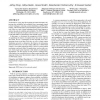Free Online Productivity Tools
i2Speak
i2Symbol
i2OCR
iTex2Img
iWeb2Print
iWeb2Shot
i2Type
iPdf2Split
iPdf2Merge
i2Bopomofo
i2Arabic
i2Style
i2Image
i2PDF
iLatex2Rtf
Sci2ools
IMC
2004
ACM
2004
ACM
On the responsiveness of DNS-based network control
For the last few years, large Web content providers interested in improving their scalability and availability have increasingly turned to three techniques: mirroring, content distribution, and ISP multihoming. The Domain Name System (DNS) has gained a prominent role in the way each of these techniques directs client requests to achieve the goals of scalability and availability. The DNS is thought to offer the transparent and agile control necessary to react quickly to ISP link failures or phenomenon such as flash crowds. In this paper, we investigate this assumption with the objective of quantifying the degree of responsiveness that can be expected from DNS. We use a combination of Web and DNS access measurements from several busy Web sites, as well as a large content distribution network, to characterize the behavior of end-systems and local DNS servers in terms of their adherence to DNS-based controls. Our results suggest that DNS is at best a coarse-grained mechanism, and poorly ...
| Added | 30 Jun 2010 |
| Updated | 30 Jun 2010 |
| Type | Conference |
| Year | 2004 |
| Where | IMC |
| Authors | Jeffrey Pang, Aditya Akella, Anees Shaikh, Balachander Krishnamurthy, Srinivasan Seshan |
Comments (0)

